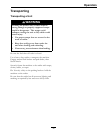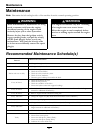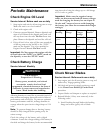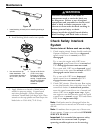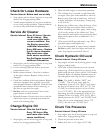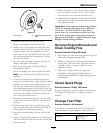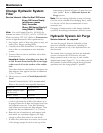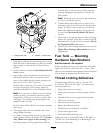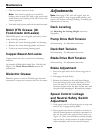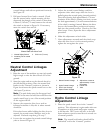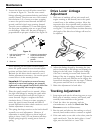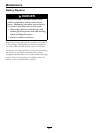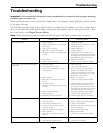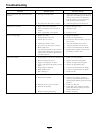
Maintenance
Figure 13
1. Charge pump cap 2. Loosen 1 1/2 turns only
1. Stop engine and wait for all moving parts to stop.
Raise the rear of the machine up onto jack stands
high enough to raise the drive wheels off the
ground.
2. Check oil level as stated in Check Hydraulic Oil
Level section.
3. Start engine and move throttle control ahead to
full throttle position. Move the speed control
lever to the middle speed position and place the
drive levers in the “drive” position.
If either drive wheel does not rotate, it is possible
to assist the purging of the charge pump by
carefully rotating the tire in the forward position.
Note: It is necessary to lightly touch the charge
pump cap with your hand to check the pump
temperature. If the cap is too hot to touch, turn
off engine. The pumps may be damaged if the
pump becomes too hot.
If either drive wheel still does not rotate continue
with step 4.
4. Thoroughly clean the area around each of the
charge pump housings.
5. To “prime” charge pump, loosen two hex socket
head capscrews (shown in Figure 13) 1 1/2 turns
only. Make sure engine is not running. Lift
the charge pump housing upward and wait for
a steady ow of oil to ow out from under the
housing. Retighten the capscrews. Do this for
both pumps.
Note: Hydraulic reservoir can be pressurized up
to 5 psi to speed this process.
6. If either drive wheel still does not rotate, stop
and repeat steps 4 and 5 above for the respective
pump. If wheels rotate slowly, the system may
prime after additional running. Check oil level
as stated in Check the Hydraulic Oil Level
section.
7. Allow unit to run several minutes after the charge
pumps are “primed” with drive system in the full
speed position. Check oil level as stated in Check
the Hydraulic Oil Level section.
8. Check hydro drive linkage adjustment as stated in
Hydro Drive Linkage Adjustment section in
Adjustments.
Fuel Tank — Mounting
Hardware Specications
Service Interval: As required
When installing the nuts on the fuel tank studs, fully
tighten the nyloc nut and back off 1/2 turn. This
allows for normal fuel tank expansion and contraction
with changes in temperature and fuel levels.
Thread Locking Adhesives
Thread locking adhesives such as “Loctite 242”
or “Fel-Pro, Pro-Lock Nut Type” are used on the
following fasteners:
• Pump drive sheave set screws.
• Square head setscrews on Hydro pump control
arms.
• Shoulder bolts in ends of speed control crank.
• OPC lever setscrews.
• Electric clutch retaining bolt.
• Pump drive idler pivot bolt.
• Thumb latch screw threads on handles.
• Caster wheel spacer nuts.
• Fuel tank bulkhead tting nuts.
Adhesives such as “Loctite RC/609 or RC/680” or
“Fel-Pro Pro-Lock Retaining I or Retaining II” are
used on the following:
29



